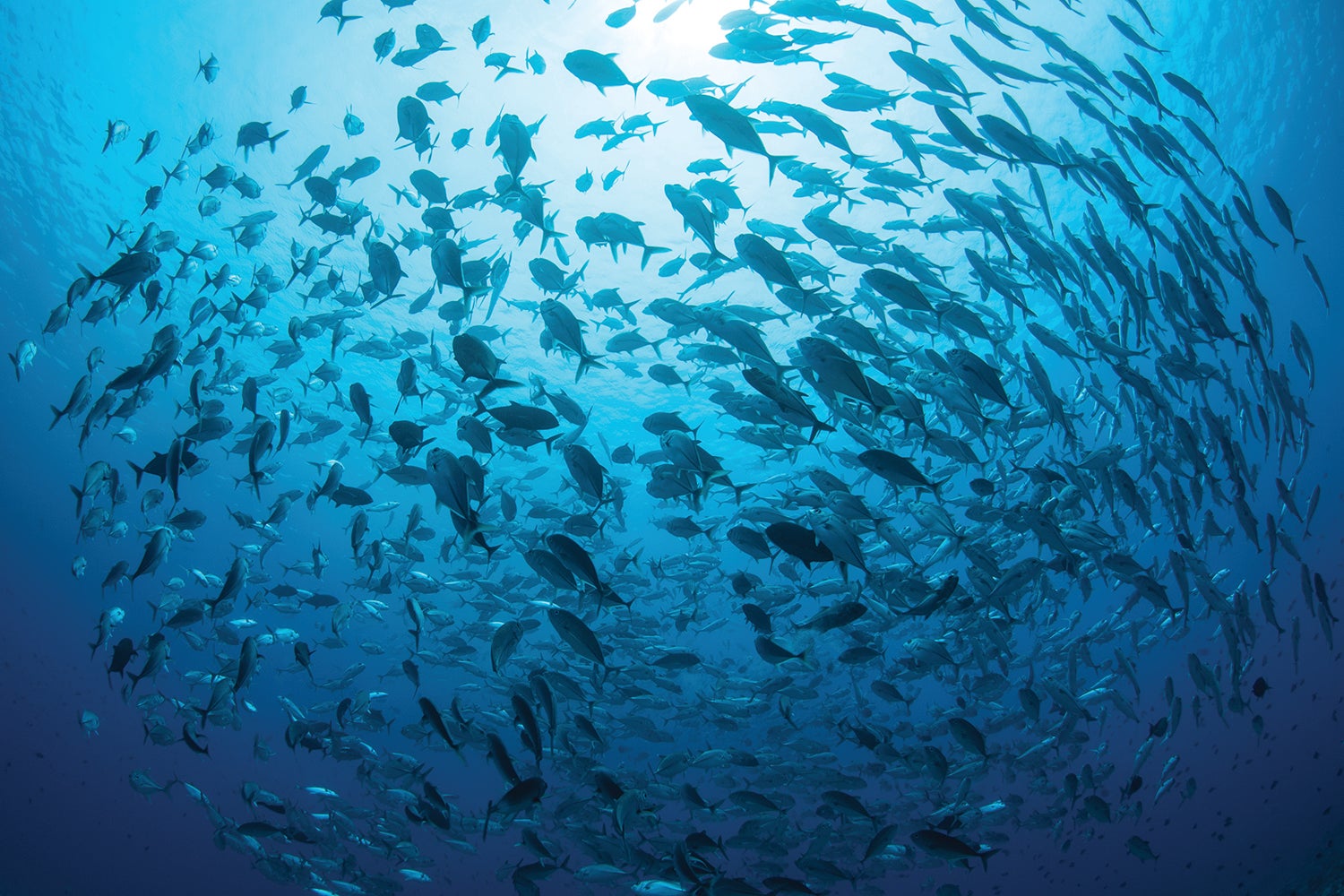Stanford experts help island nation revolutionize ocean conservation
Stanford experts help guide Palau’s initiative to create one of the world’s largest marine sanctuaries. The protected area will diversify food options for Palauans while reducing overfishing and protecting marine life amid mounting climate pressures.
A tiny Pacific Island nation is reimagining ocean conservation with guidance from Stanford researchers and international experts. In January Palau is closing 80 percent of its ocean waters to fishing, creating one of the largest marine protected areas in the world. It is the largest percentage of a country’s exclusive water with a fully protected designation – an area twice the size of Mexico.

School of fish in the open ocean off the coast of Palau. Stanford experts worked with the island nation to effectively manage one of the world’s largest marine sanctuaries. (Image credit: © ead72 / Adobe Stock)
Marine protected areas help protect cultural resources and marine life, while enhancing the resilience of resources, such as seafood, benefiting fisheries and supporting other industries such as tourism. The sanctuary stands to lend important insights to other island communities that are reliant on the oceans for economic growth and food security amid mounting climate impacts, including rising sea levels and acidification.
“Marine protected areas are cornerstones of conservation and economic development,” said Fiorenza Micheli, co-director of the Stanford Center for Ocean Solutions. “Palau is driving investment in large-scale protection to benefit people and the ocean. It is a beacon to the rest of the world.”
Palau President Tommy Remengesau Jr. asked experts from Stanford’s Center for Ocean Solutions and the Palau International Coral Reef Center (PICRC) to convene an expert working group to analyze how best to implement the new sanctuary, while also achieving food security and economic development goals. The Stanford and PICRC team presented their scientific, policy and management recommendations to Remengesau and other key leaders in Palau in December. Their recommendations include protecting threatened reef fish – such as snapper and parrotfish – outside the sanctuary, and promoting offshore seafood alternatives, such as tuna.
Protecting biodiversity and marine resources
Set to launch in January 2020, the Palau National Marine Sanctuary will be the sixth-largest fully protected ocean area in the world. Often called an “underwater wonder of the world,” the water surrounding Palau boasts remarkably healthy marine ecosystems, home to more than 1,300 species of fish and 700 species of coral, including critically endangered hawksbill and leatherback sea turtles, manta rays, seabirds, whales, sharks and tunas. The area also represents great cultural identity and socioeconomic value to native Palauans.
“Successfully implementing this new sanctuary is a legacy of immeasurable value for the people of Palau,” said PICRC CEO Yimnang Golbuu. “This is a bold move that the people of Palau recognize as essential to our survival.”
Due to fishing restrictions, the new sanctuary will also foster a path toward a more sustainable, safe and nutritious supply of seafood for Palauan citizens. Given the overexploited status of coastal resources and increasing threats of hotter sea temperatures and acidifying waters on reef fish populations in Palau, a reliable supply of deep-sea fish offers an alternate food source for Palauans. Nutritionally, deep-sea fish have higher concentrations of protein, iron, fat, and omega-3 fatty acids, which are critical to infant development, human health and disease prevention.
Reduced pressure on reefs, diversification of domestic food sources, and reduced reliance on imports can also improve the short- and long-term stability of the seafood supply in the face of environmental, political and economic change. The sanctuary is a critical piece in building a food-secure future for all Palauans.
“Palau hopes to see its marine sanctuary inspire similar initiatives by countries around the world. We believe a small island nation can have a big impact on the ocean, with ripple effects out into our larger world,” said President Remengesau.
Micheli is also the David and Lucile Packard Professor of Marine Science in Stanford’s School of Humanities and Sciences at Hopkins Marine Station and a senior fellow at the Stanford Woods Institute for the Environment.
This work was supported by the National Center for Ecological Analysis and Synthesis (NCEAS), Future Earth, the Nomis Foundation and the Gordon and Betty Moore Foundation, in close collaboration with the Palau International Coral Reef Center.
To read all stories about Stanford science, subscribe to the biweekly Stanford Science Digest.
